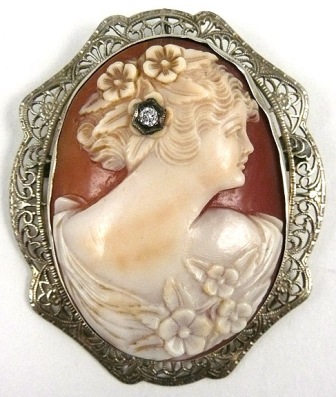Behold that gorgeous antique brooch you’ve been staring at for the last few days on the internet! It’s obviously Art Nouveau, isn’t it?
It’s often very difficult to distinguish from a genuine antique jewellery piece and a good reproduction. Here are some key points that you need to know before you shop and pay for what you think is a Victorian piece of jewellery only to find out that it’s a clever reproduction.
Being able to identify the findings that are attached to the jewellery for function rather than design is sometimes a good way to determine age, although findings can often have been altered at a later date. Some examples of “findings” are the hinges, clasps and catches on the piece. The Victorian era featured tube hinges until a more streamlined design was introduced in the later part of the era. Other types of hinges such as roll over, C shaped and safety pin types evolved over the years. A lobster catch will not be on a piece of authentic antique jewellery.
The colours and metals changed in style through the years. The art deco period featured bright primary colours while the Victorian era did not. Being able to identify the cut of the stone and the type of stone in the piece will also help in dating the piece. Modern brilliant cut diamonds, for example, were not introduced to the market until the early 20th century.
Aluminium, platinum, pot metal and copper have been the popular metals in the 20th century. White gold for example, although first introduced at the turn of the 1900s, wasn’t in wide circulation until about 1920 when it was used as a cheaper alternative to platinum. As another example, 15 carat gold was a British Empire gold standard until it was discontinued in 1932 and it was commonly used in Victorian jewellery.
But often in Victorian times there was more emphasis on the workmanship and beauty of the item than on the quality of materials used. Pinchbeck for example, an alloy of zinc and copper, was a respectable alternative to gold in the Victorian era and is commonly found at the cheaper end of the antique jewellery market today when so much importance is placed on jewellery being made of gold or platinum.
Feeling the weight of the piece can also help identify its age but, if you’re buying online, ask the seller how much it weighs. A brooch from the Victorian era can look a lot heavier than one that was reproduced in recent years but often a large piece was made reasonably light so that it didn’t pull on the wearer’s clothing. Check also to see if jewels are glued in and if the piece is hand made or the product of a mould.
A registration mark on a piece will truly give you an accurate time frame as will hallmarks. A makers mark or label is another step in identification. There are plenty of guides and forums available online to help identify hallmarks.
Lastly, try to find a picture of the item to compare with the piece in question. Often pictures are available in books, such as Carter’s Antiques Guide (Australia), or online.
Obviously, some of these checks are trickier to use if you’re buying online but if the piece is not as described when you receive it (ie. fake), then you are entitled to a full refund. Your local Trading Standards or Fair Trading agency should help you out in the event of any difficulties in this.
Do your homework. Check the seller’s credentials and use the internet for clues and, above all, ask lots of questions!

